
Rubik's Cube is a 3-D combination puzzle invented in 1974 by Hungarian sculptor and professor of architecture Ernő Rubik. Originally called the Magic Cube, the puzzle was licensed by Rubik to be sold by Ideal Toy Corp. in 1980 via businessman Tibor Laczi and Seven Towns founder Tom Kremer and won the German Game of the Year special award for Best Puzzle that year. As of January 2009, 350 million cubes had been sold worldwide, making it the world's top-selling puzzle game. It is widely considered to be the world's best-selling toy.
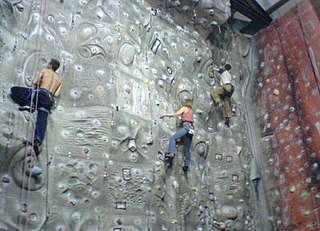
A climbing wall is an artificially constructed wall with grips for hands and feet, usually used for indoor climbing, but sometimes located outdoors. Some are brick or wooden constructions, but on most modern walls, the material most often used is a thick multiplex board with holes drilled into it. Recently, manufactured steel and aluminum have also been used. The wall may have places to attach belay ropes, but may also be used to practice lead climbing or bouldering.

The Rubik's Revenge is a 4×4×4 version of Rubik's Cube. It was released in 1981. Invented by Péter Sebestény, the Rubik's Revenge was nearly called the Sebestény Cube until a somewhat last-minute decision changed the puzzle's name to attract fans of the original Rubik's Cube. Unlike the original puzzle, it has no fixed facets: the centre facets are free to move to different positions.
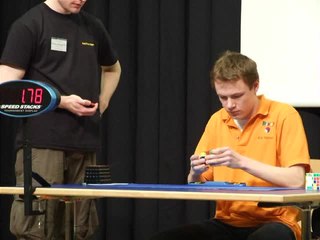
Speedcubing is the hobby involving solving a variety of twisty puzzles, the most famous being the 3x3x3 puzzle or Rubik's Cube, as quickly as possible. For most puzzles, solving entails performing a series of moves that alters a scrambled puzzle into a state in which every face of the puzzle is a single, solid color. Some puzzles have different requirements to be considered solved, such as the Clock, for which all the dials must be moved into the 12 'o clock position. The standard puzzle sizes are 2x2x2, 3x3x3, 4x4x4, 5x5x5, 6x6x6, and 7x7x7. There are also different shapes of the famous puzzles, including Pyraminx, Megaminx, Skewb, and Square-1. An individual who competes in speedcubing is known as a speedcuber.

The Professor's Cube is a combination puzzle, a 5×5×5 version of the Rubik's Cube. It has qualities in common with both the original 3×3×3 Rubik's Cube and the 4×4×4 Rubik's Revenge, and knowing how to solve either can help when working on the 5×5×5 cube.
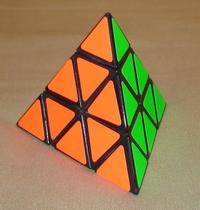
The Pyraminx is a regular tetrahedron puzzle in the style of Rubik's Cube. It was made and patented by Uwe Mèffert after the original 3 layered Rubik's Cube by Erno Rubik, and introduced by Tomy Toys of Japan in 1981.

The Square-1, also known as Back to Square One and Cube 21, is a puzzle similar to the Rubik's Cube. Its distinguishing feature among the numerous Rubik's Cube variants is that it can change shape as it is twisted, due to the way it is cut, thus adding an extra level of challenge and difficulty. The Super Square One and Square Two puzzles have been recently introduced. The Super Square One has two additional layers that can be scrambled and solved independently of the rest of the puzzle, and the Square Two has extra cuts made to the top and bottom layer, making the edge and corner wedges the same size.
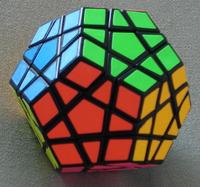
The Megaminx or Mégaminx is a dodecahedron-shaped puzzle similar to the Rubik's Cube. It has a total of 50 movable pieces to rearrange, compared to the 20 movable pieces of the Rubik's Cube.

The Dogic is an icosahedron-shaped puzzle like the Rubik's Cube. The 5 triangles meeting at its tips may be rotated, or 5 entire faces around the tip may be rotated. It has a total of 80 movable pieces to rearrange, compared to the 20 pieces in the Rubik's Cube.

The Skewb Diamond is an octahedron-shaped puzzle similar to the Rubik's Cube. It has 14 movable pieces which can be rearranged in a total of 138,240 possible combinations. This puzzle is the dual polyhedron of the Skewb. It was invented by Uwe Meffert, a German puzzle inventor and designer.

The Hoberman BrainTwist is a 3D mechanical puzzle designed and marketed by Chuck Hoberman's company Hoberman Designs. The puzzle is in the same family as the Rubik's Cube and other puzzles that involve manipulating and scrambling colored face elements with the goal of returning them to their original order from a randomized state, commonly called twisty puzzles. This puzzle is unique in that in addition to solving one set of tetrahedral faces the puzzle can be flipped inside-out through an intermediate stellated shape to reveal another (dual) tetrahedron with a set of 4 different colored faces. The puzzle also has an alternate solution in which the apices are each a uniform color.
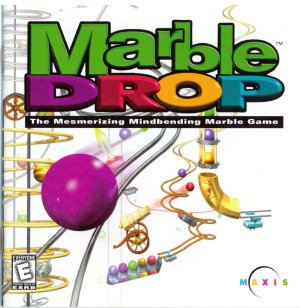
Marble Drop is a puzzle video game published by Maxis on February 28, 1997.

The Pyramorphix is a tetrahedral puzzle similar to the Rubik's Cube. It has a total of 8 movable pieces to rearrange, compared to the 20 of the Rubik's Cube. Though it looks like a simpler version of the Pyraminx, it is an edge-turning puzzle with the mechanism identical to that of the Pocket Cube.

Rubik's Games is a, five games in one, PC game created for Windows 95/98 developed in part by Ernő Rubik with Androsoft and was published by Hasbro Interactive. It was part of Hasbro's classical games collection of PC related games, translating their most famous board games into best possible quality video games. A history of the Rubik's Cube and its inventor, written out in a webpage type file, with pictures is available from the Menu.

The V-Cube 6 is a 6×6×6 version of Rubik's Cube. The first mass-produced 6×6×6 was invented by Panagiotis Verdes and is produced by the Greek company Verdes Innovations SA. Other such puzzles have since been introduced by a number of Chinese companies, some of which have mechanisms which improve on the original. Unlike the original puzzle, it has no fixed facets: the center facets are free to move to different positions.

The V-Cube 7 is a combination puzzle in the form of a 7×7×7 cube. The first mass-produced 7×7×7 was invented by Panagiotis Verdes and is produced by the Greek company Verdes Innovations SA. Other such puzzles have since been introduced by a number of Chinese companies, some of which have mechanisms which improve on the original. Like the 5×5×5, the V-Cube 7 has both fixed and movable center facets.

Rubik's 360 is a 3D mechanical puzzle released in 2009 by Ernő Rubik, the inventor of Rubik's Cube and other puzzles. Rubik's 360 was introduced on February 5, 2009 at the Nürnberg International Toy Fair ahead of its worldwide release in August.

The Helicopter Cube is a Rubik's Cube-like puzzle invented by Adam G. Cowan in 2005 and built in 2006. It is also in the shape of a cube. At first glance, the Helicopter Cube may seem like a combination of the 2x2x2 and the Skewb, but it actually cuts differently, and twists around cube edges rather than cube faces. The purpose of the puzzle is to scramble the colors, and then restore them back to their original state of a single color per face.

The V-Cube 8 is an 8×8×8 version of the Rubik's Cube. Unlike the original puzzle, it has no fixed facets: the center facets are free to move to different positions. The design was covered by Panagiotis Verdes' patent from 2007 but Verdes Innovations SA did not produce it for sale until 2014. Other 8×8×8 cubes are produced by the Chinese companies ShengShou, MoYu, and YuXin.

The Gear Cube is a 3-D combination puzzle designed and created by Dutch puzzle maker Oskar van Deventer. It was initially produced by Shapeways in 2009 and known as "Caution Cube" due to the likeliness of getting fingers stuck between the gears while speedcubing. Later, in 2010, it was mass-produced by Meffert's as the "Gear Cube".



















